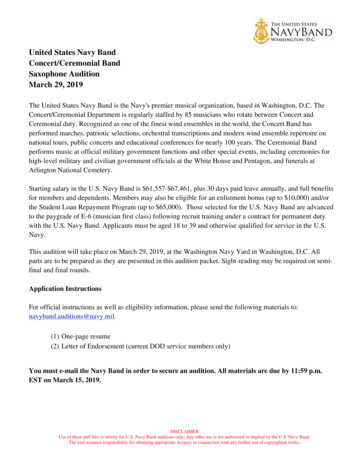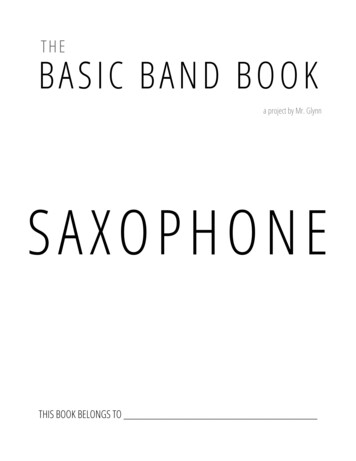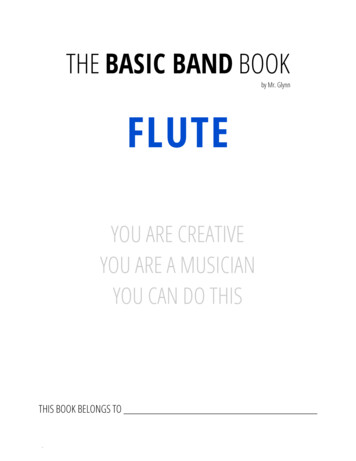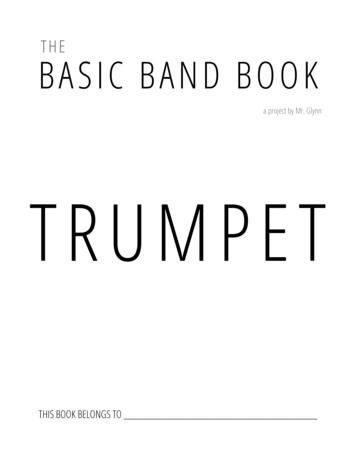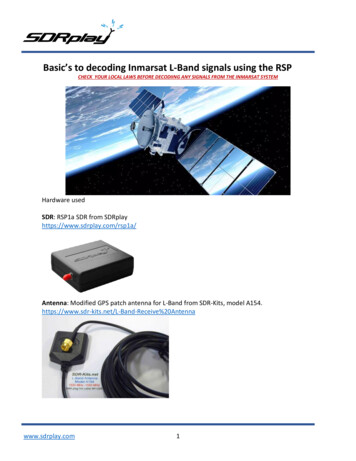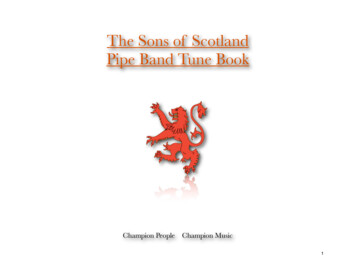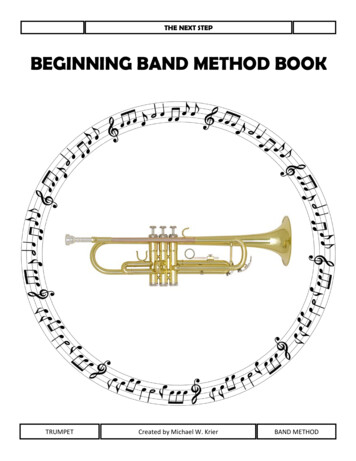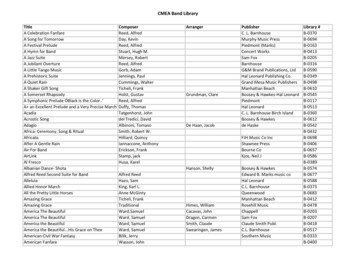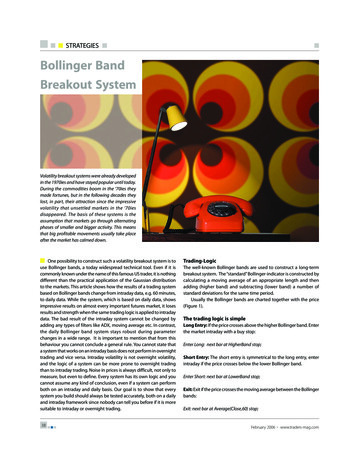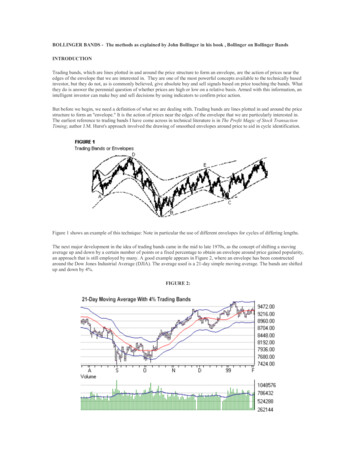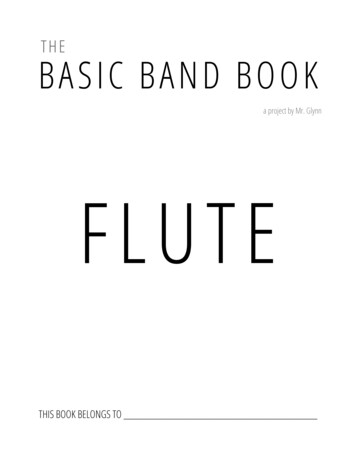
Transcription
THEBASIC BAND BOOKa project by Mr. GlynnFLUTETHIS BOOK BELONGS TO
Before we begin YOU AREC R E AT I V EYOU ARE AMUSICIANYOUCAN-3-DOTHIS
THE MUSICAL ALPHABETFORWARDSBACKWARDSE F G A B C D E F G A B CGFAEBCDA-4-BCDEFGFEDCBA
Q & A ––––1) What letter comes after G ?2) When we move forwards in the alphabet, does the sound go up or down?3) When we move backwards in the alphabet, does the sound go up or down?PENCIL GAMES ��–––––––––––WITHOUT looking at the previous page, fill in the missing letters:forwards:1)A D C2)E B Fbackwards:3)C B F A4)F G CBAND @ HOMEwww.BasicBand.info1) Use the video online to help you.2) Say the Musical Alphabet forwards and backwards 5 times in a row perfectlywithout looking at it.3) Challenge your friends and family to say the Musical Alphabet forwards andbackwards and see who can do it well.-5-
BREATH SUPPORTBreath Support: how we use our air to play a wind instrument.Use your stomach to push the air up and out of your body.BUILDING LUNG CAPACITY ) Breathe air IN like you are whispering the letterO2) Breathe air OUT like you are whispering the wordTOEALWAYS DO THIS WITH EXCELLENT POSTUREUSE AS MUCH AIR AS POSSIBLESITTING UP STRAIGHT & TALLKEEP YOUR SHOULDERS RELAXED!-6-
BREATHING EXERCISES ��––At the same speed as the second-hand of a clock:1) Breathe IN for 4 countsOUT for 4 counts2) Breathe IN for 3 countsOUT for 5 counts3) Breathe IN for 2 countsOUT for 6 counts4) Breathe IN for 1 countOUT for 7 countsMAKE UP SOME OF YOUR OWN COMBINATIONS!BAND @ HOMEwww.BasicBand.info1) Carefully cut out the four bulls-eyes on the next page.2) Challenge your friends and family to see who can blow a bulls-eye againstthe wall for the longest amount of time (aim right for the center!).3) Go through the steps above sitting with good posture.-7-
-8-
-9-
- 10 -
SOLFÉGE SYLLABLESFA SO LA TI DO RE MI FA SO LA TI DO REM I NO RMAJORREMEMBER THIS ND @ HOME1) Music always has a resting tone, or thetonic, or the home notewww.BasicBand.info1) Practice speaking through thesolfége syllables forwards andbackwards2) The resting tone in Major tonality is DO3) The resting tone in minor tonality in LA- 11 -
Flute Lesson 1FLUTE EMBOUCHUREEmbouchure: how to form your mouth to play an instrument.THE FOUR STEPS ��–––––––––1) Close your mouth so that your lips are together and make a line.Hint: Say “Em”2) Bring the head joint to your mouth and press the circle against your lips.3) Roll the head joint down and away from you until you feel the edge of the tonehole resting on your lip-skin line.4) Take a deep breath and blow out air like you’re saying “pooh”. Remember touse a tight and fast air stream.BAND @ HOMEwww.BasicBand.info1) Go through all of the steps above. Watch the video to help you.2) Use a mirror to see what your embouchure looks like, and try to copy thepictures on the next page.3) Make a good sound on the head joint 5 times in a row, taking it away fromyour mouth after each time.- 12 -
GOOD EMBOUCHURE ��––––- 13 -
Flute Lesson 4HOLDING THE FLUTE1TH12233UMBNPINPIKYTHUMKYBLEFT HANDRIGHT HANDPALMFACINGTOWARDSYOUPALMFACINGAWAY FROMYOUHELPFUL HINTS ��––––––––––1) Your right hand should be holding the imaginary cheeseburger.2) When lifting fingers off the keys, keep them as close to the keys aspossible.3) The weight of the flute is held in two places:1. Right hand thumb2. Base of your first finger in the left hand- 14 -
LEFT HANDP1THUMB23RIGHT HANDKINYNPI123THUMBLEFT HANDRIGHT HANDBAND @ HOMEwww.BasicBand.info1) Use the video online to help you.2) Make a sound with only your right hand fingers down.3) Make a sound with only your left hand fingers down.- 15 -KY
- 16 -
Flute Lesson 5PLAYING POSITIONTHE FOUR STEPS ��–––Start with good posture, then 1) Turn slightly to the left.2) Tilt your head slightly to the right.3) Elbows up and out (not too far!).4) Shoulders relaxed.BAND @ HOMEwww.BasicBand.info1) Use the video online to help you.2) Go through the steps above every time before you play.- 17 -
Flute Lesson 8TONGUINGTonguing: how we start the sound with the tongueHOW TO TONGUE ��––––––––1) Say the word TOO.2) You will feel your tongue go against the back of your top teeth.3) Say TOO 3 times in a row, connected, then separated.4) Do it again, but with your airstream only (no voice).5) Do this same thing on the flute headjoint.TROUBLESHOOTING ��––––––‣ Do this exercise, but put your palm in front of your mouth to see if youcan feel air coming out the entire time.- 18 -
CONNECTED ��–––––––––––––Should sound like this:TOOOOOOOO–TOOOOOOOO–TOOOOOOOODon’t breathe in between. This should be one breath out!SEPARATED ��––––––––––––––Should sound like 3 separate silence)BAND @ HOMEwww.BasicBand.info1) Go through all of the steps above. Watch the video online to help you.2) Play both connected and separated rhythms.3) Play different rhythms for someone at home and see if they can tell if it isconnected or separated.- 19 -
FLUTE FINGERINGSALWAYS REMEMBER ��–––––1) Keep your fingers close to the keys, always ready to push down.FINGER POSITION ��––––––––This is the specific part of thefinger which covers the keys. Ifyour finger does not cover thekey properly, air will escape andit will cause shrill and squeakynoises when playing.BAND @ HOMEwww.BasicBand.info1) Use the video online to help you.2) Ask someone to watch you play these notes and have them look to see ifyour fingers are staying close to the keys or coming off too far.- 20 -
B A GF E DLEFT HANDRIGHT HANDPINKYTHUMB- 21 -
Bb is DOTIDOREMIBbQ & A ––––1) Is this Major or minor?2) Which note is your resting tone?- 22 -
G is LASILATIGDOREMIQ & A ––––1) Is this Major or minor?2) Which note is your resting tone?- 23 -
Eb is DOTIDOREMIEbQ & A ––––1) Is this Major or minor?2) Which note is your resting tone?- 24 -
C is LASITILACDOREMIQ & A ––––1) Is this Major or minor?2) Which note is your resting tone?- 25 -
CHROMATIC SCALEA#ORBbB CC#ORDb- 26 -DD#OREbE
FF#ORGbGG#ORAbAA#ORBbALWAYS REMEMBER ��–––––1) The Chromatic Scale is when you play every note on the instrument, in order,up or down.2) When you go up, use sharps ( # ). When you go down, use flats ( b ).3) It can start and end on any note.- 27 -
MUSIC NOTATIONjust like you take notes to help you remember what yourteacher told you, we also have notes in music. They existto remind you of what you have already learned.It is called Music Notation.BAND @ HOMEwww.BasicBand.info1) Watch the Lesson for Everyone video called “Music Notation” to be sure youunderstand it.- 28 -
STEP 1 – Hold out your hand.5 How many fingers do you have?4How many spaces in betweenthose fingers?4332211STEP 2 –Just like you have lined paper towrite notes on, we also have aspecial type of lines, called amusic staff. The staff has 5 lines, and 4 spacesin between the lines just like yourhand. ��––––––––––––––STEP 3 – Let’s recall some of the solfége syllables:SOFAMIREDOTILA- 29 -
STEP 4 – We can make any line or any space on the staff The picture below showsDODOon the 3rd ��––––––––––––– As long as we know whereeverything else isDOis, we can figure out whereSTEP 5 – When we write notes on the music staff, they alternate between lines andspaces:line – space – line – space – line – space – line – space – line Think about what the solfége syllables for the rest of the lines and spacesare going to �––––––––––––- 30 -
STEP 6 – Instead of writing the syllables on every line and space, we are going to drawa line to show us where DO isTo tell us which pitch to sing or play, we are going to draw oval notes on itsline or –––––––––STEP 7 – The arrow points to DO Write in the rest of the solfége syllables Sing these - 31 -
- 32 -
MAJOR TONAL PATTERNSDO is ��––––––Be expressive when performing with your voice and with your instrument!- 33 -
DUPLE RHYTHM PATTERNS12345678Be expressive when performing with your voice and with your instrument!- 34 -
TRIPLE RHYTHM PATTERNS12345678Be expressive when performing with your voice and with your instrument!- 35 -
- 36 -
PLAYING RECORDOnly check off each day that you spend at least 10 minutes playing your instrument.DATEASSIGNMENT9/5The Musical Alphabet - p. 4M Tu W Th F Sa SuPARENT/GUARDIANSIGNATURER.Glynn- 37 -
FLUTE EMBOUCHURE 1) Close your mouth so that your lips are together and make a line. Hint: Say “Em” 2) Bring the head joint to your mouth and press the circle against your lips. 3) Roll the head joint down and away from you until you feel the edge of the tone hole resting on your lip-skin line.
